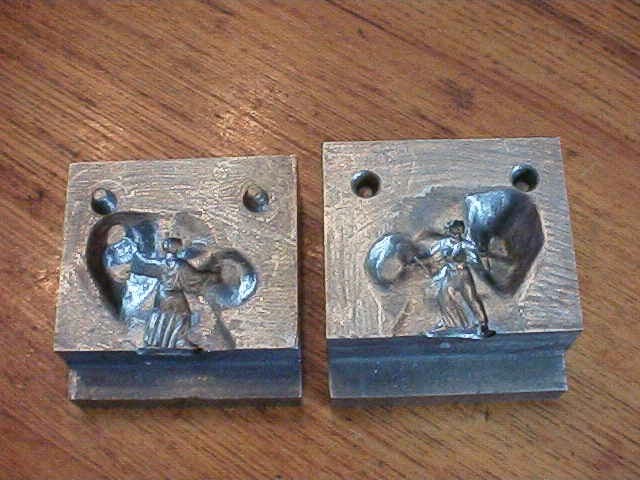


| Princess Leia Steel Production Mold (Unproduced, Exaggerated Features) | |

Steel Production Mold for Micro Leia with Unproduced, Exaggerated Features: This is the actual steel production mold relating to the "enhanced" 4-up seen here. The molds used for mass-producing the Micro figures were created using a pantograph, a device capable of translating detail from one scale into another while simultaneously cutting it into steel. This first image shows the two halves of the mold laid open side-by-side. You can clearly see the two negative impressions of the figure halves, into which the molten metal would be injected, as well as the "keys," which insured that the mold halves would line up correctly when clamped together.
This second image is a close up of the mold half responsible for the front of the figure. You might be able to tell that the breasts are greatly exaggerated.
Here's a close-up.
Here you see the opposite mold half, which includes the large posterior that supposedly upset Carrie Fisher and initiated this whole affair. What we believe happened here is that the original 4-up (complete with large behind) was used to create a mold by the vendor contracted by Kenner to do this work. Then, after the complaint about the figure's posterior was registered, the vendor was asked by Kenner to destroy the mold. The whole situation must have seemed a bit ridiculous to the folks working for this vendor, and they quickly saw in it the potential for a great joke. They "destroyed" the mold all right, but instead of disfiguring it in the standard fashion, they cut large indentations in the area corresponding to the figure's breasts. Resin test figures--sometimes called "squeezings"--were then cast using the "destroyed" mold, which were then sent back to Cincinnati were the folks on the Kenner end of the project had a good laugh.
When the two halves are clamped together, they conform to each other perfectly. As you can see, the only area which is left open is that corresponding to the base of the figure. This is where the molten metal material would be injected during mass-production. But, of course, this mold was never used for such a purpose; it's doubtful that more than a few metal figures were ever produced using it. Once the metal was injected into the mold cavity, I believe a type of steel plate bearing the copyright information and product number would be impressed upon the flat area under the base.
One of the interesting aspects of this piece is found on the outside surface of one of the mold halves. Here can be seen the half-formed impression of the Leia figure. Apparently, something was wrong with the first attempt at creating this mold and it was abruptly aborted. Rather than wasting the piece of steel on which the impression was made, they simply flipped it over and made use of its opposite side. Original production molds and dies are exceedingly rare-- moreso than typical prototypes, or even original artwork. Since they represent the principle investment made by a toy company in developing their product lines, they are not easily parted with. Unlike items such as proof cards, hardcopies and first shots, which, for the most part, become garbage once they've played their parts in the developmental process, production molds are never simply discarded. Rather, they are stored, destroyed or sold to another company. Consequently, it's incredibly nice to see something like this Leia mold, especially since it's got such a great story associated with it. Special thanks are owed to an anonymous collector for helping to uncover this mold and the story behind it. For information regarding this unproduced Leia figure, click here. |
| Description by: | Ron Salvatore |
| Photo: | Chris Georgoulias |
| From the collection of: | Anonymous |
| Country: | United States |
| Film: | A New Hope |
| Licensee: | Kenner |
| Year: | 1977 |
| Category: | Prototypes / Micro Collection |